Learning to read in Japanese is difficult, but we can show you a simpler and faster way to do it. After mastering the 46 hiragana and 46 katakana characters, you will need to acquire a basic knowledge of more than 2,000 kanji, most of which are associated with more than one possible pronunciation, and then you will need to engage in extensive reading practice.
Instead of studying each of those kanji characters in isolation with the use of flashcards or learning to write them all by hand, hoping someday to arrive at the point where you can actually read Japanese text, why not learn kanji quickly with the help of mnemonics and then practice reading them in real sentences almost immediately? We have developed six books that make it possible for you to do just that and to learn to read in Japanese as efficiently as possible.
Four Japanese Readers
The books are available in three formats.
1. As paperback books published by Kindle, a subsidiary of Amazon. These books are available for purchase at Amazon, at Amazon UK, at Amazon Japan, etc.
2. As paperback books published by Ingram Spark, which sells through bookstores and other outlets that are not affiliated with Amazon, including at Barnes and Noble, at Booktopia in Australia, at Walmart, at Thriftbooks and at other sites. The Ingram Spark books have the advantage of being somewhat lighter and thinner than the Kindle books, but we have noticed that they are more likely to affected by printing problems, such as pale text.
You may purchase the Ingram Spark books directly by using the yellow “Buy Now” buttons on the page below.
Our first Japanese Reader is Learn to Read in Japanese: A Japanese Reader, Volume 1. Students who use this book will learn to read 608 basic kanji. It contains a Core Kanji catalogue describing those characters. The book is 552 pages long, and it includes more than 4,200 Japanese sentences for reading practice.
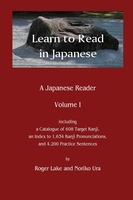
Our second Japanese Reader is Learn to Read in Japanese,Volume 2. This book is 577 pages long, and it teaches 600 additional kanji, for a total of 1208. It contains a Core Kanji catalogue describing those characters, and it also includes more than 1,600 sentences and 2,900 Japanese terms for reading practice.
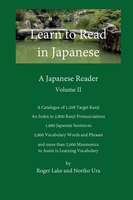
Our third Japanese Reader is Learn to Read in Japanese, Volume 3. It is 528 pages long, and it teaches 320 additional kanji, for a total of 1528. It contains a Core Kanji catalogue describing those characters, and it includes more than 900 Japanese sentences and 2,100 terms for reading practice.
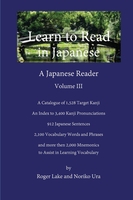
Our fourth Japanese Reader is Learn to Read in Japanese, Volume 4. It is 289 pages long, it teaches 560 additional kanji, for a total of 2,088, and it includes 1,623 Japanese sentences and more than 3,800 terms for reading practice. Due to space constraints, it does not contain a Core Kanji catalogue, but the Core Kanji catalogue shown below and sold separately is designed to be used with this Reader.
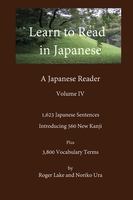
A Core Kanji Catalogue for Learning Japanese Kanji
In order to start reading in Japanese, you will need to acquire a basic knowledge of the kanji that Japanese people most often use. We have assembled Core Kanji: a Catalogue of 2,088 Essential Kanji, listing 2,088 characters for you to learn. This book is 448 pages long and includes a Kanji Pronunciation Index listing 4,200 kanji pronunciations, allowing you to look up a kanji easily when you know one or more of its pronunciations.

Please note that the first three Japanese Readers described above each include a preliminary version of this Core Kanji catalogue, describing all of the kanji that have been introduced in the curriculum up to that point. Therefore, this complete Core Kanji catalogue is not necessary for students who are studying Readers 1, 2 and 3. However, this complete version of the catalogue will prove to be a valuable reference book when you need to look up kanji characters in the future.
Like the earlier kanji catalogues that are included in the first three Readers, the Core Kanji stand-alone catalogue lists each kanji with the basic information required to get started reading. This information consists of: 1) the pronunciations that students are likely to encounter for the character; 2) the meanings of the character; 3) one or more sample Japanese words for each of the character’s possible pronunciations; 4) a memorable description of the character, to help students to recognize it more easily in the future (such descriptions often focus on differences between the current kanji and other similar ones); 5) a brief sentence that contains retrieval cues (or mnemonics) for each of the character’s possible pronunciations; 6) comparisons between the character and other similar kanji; and 7) (in the stand-alone catalogue only) kanji groups, in which kanji with similar traits are grouped together.
As a bonus, the Core Kanji stand-alone catalogue contains all of the files and instructions that you will need in order to learn and use our powerful kanji recognition tool known as Kanji ID. These files include the Core Kanji catalogue, a Kanji Group Index, a Kanji Trait Index and a Kanji Table, all designed to help you to recognize all 2,088 kanji based on their dominant traits. You can read more about how to use this kanji recognition technique on the Kanji ID page.
A Glossary of Terms Found in our Japanese Readers
As you study these books, you will be exposed to an increasing number of Japanese vocabulary terms. This increase in Japanese vocabulary is an inevitable result of the fact that each kanji character is associated with its own unique words.
We have decided to try to help students organize and remember this vocabulary by publishing a Glossary of the more than 9,700 Japanese terms that appear in the four Readers shown above. The glossary cannot replace a Japanese dictionary, but it contains all of the vocabulary terms that you will need to know while using our Readers, together with mnemonics and comparisons among different terms.
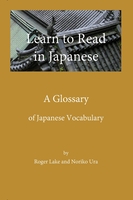
3. Our six books are also available in a third format: PDF files. You can use these files for reading practice, but only on a computer or laptop where you can open multiple windows, because our tests indicate that searching for vocabulary or kanji in large PDF files like these on smaller electronic devices is slow and awkward. In our opinion, to conduct reading practice in these documents in the most efficient way, it’s best to begin by placing them in separate windows on a screen. When the documents are arranged in this way, students can easily turn from, say, Japanese text in one window to English text and romaji in another window, to information about kanji in a third window, to similar or related kanji in a fourth window (for comparison purposes), to a Pronunciation Index for looking up kanji in a fifth window, to glossary terms in a sixth window, and/or back to the Japanese text in the first window. Please see Japanese Reading Practice on a Computer Screen for more information. Here is a link to the PDF files:
How can students read Japanese and learn kanji at the same time?
Although it might seem impractical to start reading practice before you know kanji very well, this approach is firmly grounded in a study technique known as Active Recall, which can be defined as “learning by answering questions.” Active Recall is the technique that underlies these Japanese Audio Flashcard Lessons, and it is also the basis of flashcard learning generally. In addition, the Pimsleur method and the “Learn in Your Car” method, both described here, are based on Active Recall.
When you look at a Japanese word and try to read it unassisted, you are essentially asking yourself the questions, “How is this word pronounced, and what does it mean?” These simple questions force your brain to work to recall each character, its pronunciation and its meaning. Since there is no penalty for incorrect answers and since the answers to the questions that you can’t answer are immediately available, Active Recall is an enjoyable way to learn. When you are able to answer questions correctly, you will experience considerable satisfaction and a sense of competence. Studies have shown that Active Recall is highly effective for building strong memories, compared to more passive study methods.
As you read the books, you will find that all of the help that you need to learn how to read Japanese is close at hand. If you relax and read the sentences at your own speed, you will be exposed to the same kanji repeatedly in different situations. By simply reading and availing yourself of the feedback and the other assistance that the books provide, you will soon learn kanji and start reading Japanese text.
Where can I find reviews of these books?
You can read reviews of some of our books that teach kanji and help you learn to read Japanese on Amazon US, Amazon UK, and Amazon Japan. In addition, there are two reviews on Tofugu.com, at this site (the review is the 4th item from the top) and also at this site (the review is the 2nd item from the top).
How to Use the Japanese Readers
In all four Japanese Readers, we make it easier for you to learn to read Japanese by introducing new kanji at the beginning of each chapter and then asking you to take a quick pre-test on their pronunciations before you start to read. The practice reading material in each lesson includes only kanji characters that you know or are in the process of learning, and we provide immediate feedback about your reading accuracy in the form of same-page romaji equivalents and translations.
We provide at least three practice sentences for each new kanji. In addition, in Readers 2, 3, and 4 we include thousands of Japanese words and phrases for vocabulary reading practice. This vocabulary comes from three sources: the examples in the Kanji Catalogue, the practice sentences in each chapter, and (for Readers 2 and 3) the optional supplemental reading material available online.
These books are designed to help you learn to read Japanese in five steps:
Step One. Core Kanji Catalogue. Before you start a chapter, turn to the Core Kanji catalogue and take some time to review the new kanji that are listed in the New Kanji table at the beginning of the chapter. Your aim should be to acquire the ability to recognize each kanji and associate it with its pronunciations.
Step Two. Pronunciation Pre-Test. Next turn to the chapter that you are about to start reading and take the “Pronunciation Pre-Test.” To do this, look at the New Kanji table and try to voice each of the pronunciations for all of the kanji in the table. Use the table at the bottom of the page to check your accuracy. Repeat this test several times until you feel ready to start reading.
Step Three. Vocabulary List with Mnemonics. Next start reading the Vocabulary List, being careful to cover the “answers” on the right side of the page with a piece of paper or your thumb. You will usually have a chance to practice reading each new kanji multiple times in different words. You will also see mnemonics for most of the words that appear in the Vocabulary Lists.
Step Four. Practice Sentences. Next read the Practice Sentences that are provided in each chapter. This is where you will really feel that you have started to learn to read Japanese. Again, be sure to cover the text on the right side of the page as you read, but don’t hesitate to uncover it if you aren’t sure about kanji pronunciations or when you don’t know how to translate the Japanese text.
Step Five. Supplemental Reading (Readers 2 and 3 only). We hope that you will take this last step, but it is optional. We have identified some fascinating Japanese language articles online that use only the kanji that you have already learned. These articles are available from “Satori Reader” (73 articles referenced in the second Reader) and from “News in Slow Japanese” (44 articles referenced in the second Reader and 98 articles in the third Reader). As you read these articles, you will see that you have made significant progress in your effort to learn to read Japanese. Please click on this link to read more about these supplemental resources.
Please watch this video to see how to use the print version of the book “Learn to Read in Japanese, Volume I,” to learn how to read Japanese.
Stroke Orders
To acquire the ability to learn kanji and other characters as they are actually written in Japan, we suggest that you spend some time writing them in accordance with their prescribed stroke orders. If you become familiar with stroke orders, you will be more likely to recognize the characters when they are written in non-standard fashion, as they often are in Japan. To see the prescribed stroke orders for hiragana, katakana, and the 608 kanji that we teach in the first book, please download and save the following files. You may wish to print these documents and refer to them when you practice writing these characters.
Kanji Stroke Orders for Volume 1, updated 05-19
If you have any questions or comments about the books, please write them in the box below (you will need to scroll all the way to the bottom of the page). We will do our best to reply to every message that we receive, and we will post the ones that are of general interest on this page. If you would rather contact us privately, you may send an email to administrator@japaneseaudiolessons.com.
Next, More About Learning to Read in Japanese
Absolutely wonderful tome of knowledge. I am so grateful to you both. I just noticed I had an email for Volume III and immediately without hesitation clicked the links to order it, and also the glossary. These will be great additions to my collection. Your books and your audio lessons and your transcripts have been absolutely crucial in my studies and I truly appreciate everything you have done for us learners. These books are also a STEAL for the quality and quantity of content you have packed into them not even including all of the free resources that you offer on your website, so thank you so much again.
Thank you, Jared. We are very happy to hear that you have found the books helpful.